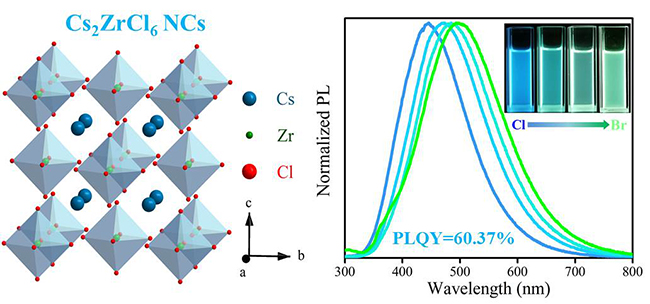In recent years, all-inorganic CsPbX3 (X = Cl, Br, I) perovskite nanocrystals have attracted extensive research attention due to their excellent photoelectric properties. However, the problems of Pb toxicity and poor stability hinder their practical application.

Lead-free perovskite Cs2ZrCl6 NCs with a PLQY up to 60.37% is synthesized (Image by LIU Siping and YANG Bin)
A research group led by Prof. HAN Keli from the Dalian Institute of Chemical Physics (DICP) of the Chinese Academy of Sciences (CAS) synthesized vacancy ordered Cs2ZrBrxCl6-x(0≤x≤1.5) double perovskite nanocrystals (NCs) for the first time by hot injection method.
This study was published in Angew. Chem. Int. Ed. on August 22.
The Cs2ZrCl6 NCs exhibited long-lived triplet excited state, featuring highly efficient photoluminescence (PL) quantum efficiency due to thermally activated delayed fluorescence.
The scientists also revealed the mechanism of TADF by detailed experimental characterizations including temperature-dependent photoluminescence spectra, temperature-dependent time-resolved photoluminescence spectra, nanosecond transient emission spectra, and pump-probe femtosecond time-resolved spectra.
TADF is promising luminescence mechanism for obtaining high exciton utilization. It is common in solid organic molecules or metal-organic complexes, but rarely reported in all-inorganic colloidal nanocrystals.
The study provides a unique strategy for the development of new inorganic phosphors. It was supported by the National Key Research and Development Program of China and the National Natural Science Foundation of China. (Text by LIU Siping and YANG Bin)